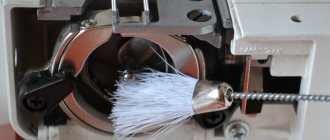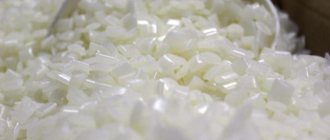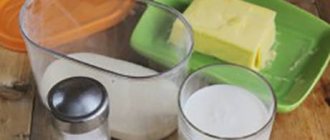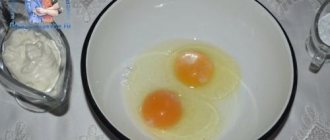What is epoxy, application instructions
The main polymer of the epoxy adhesive mass is a resinous substance. Resin (epoxy) has technical characteristics similar to glue and is sold together with a hardener. The scope of application of epoxy is similar to glue - agriculture and industry, therefore it is sold as an independent adhesive material. Also, the production instructions “How to use epoxy resin” indicate that it is suitable for pouring floors, making mosaics, design creativity and preparing building mixtures.
Video description
You can watch the whole truth about epoxy resin in the video:
Epoxy is impregnated with fiberglass and industrial threads, added to fiberglass and some types of plastics, and used in the production of paints and varnishes, military body armor, and the filling of circuit boards and PC chips.
Resin and glue have the same technical characteristics, and also require heating for better hardening. The only difference between the resin is that it is an independent two-component substance with a longer hardening time. And glue is a mass with a complex multi-component composition.
The resin is not used in its pure form; it must be mixed with the included hardener. You can also look up how to dilute epoxy resin correctly on the Internet, read the included instructions, ask specialists, as well as consultants in the store.
The resin can be mixed with powder fillers to increase strength, viscosity, beautiful color, streak-free, and fill surface pores (up to 40%). To do this, take chalk, alabaster, cement, aerosil, graphite, titanium and aluminum powder.
Epoxy resinSource www.carbonkevlar.ru
The instructions “How to dilute epoxy resin with a hardener” indicate that polymerization is carried out under the same conditions as for glue: air access, compliance with safety measures, surface preparation, mixing components, gluing process.
Epoxy comes in various types. The epoxy-diane type is very popular for paints and varnishes of a certain marking (for example, ED-16, EP SM PRO, ED-10, etc.). Popular brands “Khimprom”, “EPS 2106”, “Mila Group”, “Leonardo”, “Ekovanna”, etc. have increased strength and hardness.
Epoxy in large packaging Source static.tildacdn.com
When answering the question of how to dilute epoxy resin with a hardener (proportions), it is worth pointing out that the manufacturer must indicate the dilution in mg and the required temperature on two bottles. Different manufacturers indicate different polymer ratios, but they differ only slightly. The normal proportions are 10:1 (the first number is epoxy), 10:6, 10:4, etc. Bottles with marks allow you to make no mistakes in the calculations. If there are no marks on the bottle, use improvised means, for example, kitchen measuring cups.
Clear epoxy for furniture and countertopsSource static.tildacdn.com
Briefly about the main thing
The main component of any epoxy adhesive is resin.
Epoxy glue and resin come in various types, the scope of which is determined by their technical characteristics and properties.
In order for the resin to begin to have adhesive properties, it must be mixed with a hardener. The included instructions for the adhesive describe in detail how to dilute the epoxy resin.
Epoxy glue dries in a few hours. The resin hardens for several days.
The glue is not used for repairing items in contact with food. The resin is harmless to human health.
The epoxy adhesive composition does not work with Teflon, polyethylene, silicone, nickel and chrome-plated surfaces - the surface of such materials begins to deteriorate when combined with an adhesive.
If the packaging is damaged, the glue and resin lose their properties.
Installation work with adhesives requires compliance with safety measures. If necessary, they are heated.
Storing in a dark place extends the shelf life of the resin and glue.
Precautionary measures
When working with adhesive, it is important to follow safety rules. The substance creates toxic fumes, so use a respiratory protection product that has a carbon filter. Joints should be glued with epoxy glue in an open area or in a ventilated (well ventilated) room.
Before starting to knead the composition, put on rubber gloves. People suffering from allergies should pay special attention to skin protection products. It is prohibited to use tableware for mixing glue components.
Temperature
Epoxy resin melts at 150-180 degrees, almost without losing its strength. There are also brands that can be heated up to 400 degrees for a short time and up to 250 degrees for a long time.
Is epoxy resin harmful to health?
Cured epoxy (when used correctly) does not cause any harm to human health. The only harm it can cause is in the industrial sphere, when when it hardens, unhardened resin still remains in the mixture. Such a residue that enters the human body can cause irreparable harm. Uncured epoxy is harmful to humans and can seriously impair their health.
Health risks
The main risk associated with the use of the material is often related to the hardener component rather than the epoxy resin itself. Amine hardeners are generally corrosive, but may also be classified as toxic or carcinogenic/mutagenic.
Aromatic amines pose particular health hazards (most are known or suspected carcinogens), but their use is currently limited to industrial applications and the safer aliphatic or cycloaliphatic amines are generally used.
Liquid epoxy resins in their uncured state are generally classified as an eye and skin irritant. Solid epoxy resins are generally safer than liquid epoxy resins, and many are classified as non-hazardous materials.
One specific risk associated with epoxy resins is sensitization. The risk has been shown to be more pronounced in epoxy resins containing low molecular weight epoxy thinners. Exposure to epoxy resins can cause an allergic reaction over time.
Sensitization usually occurs due to repeated exposure (eg, poor occupational hygiene or lack of protective equipment) over a long period of time.
The allergic reaction sometimes occurs with a delay of several days after exposure. It appears in the form of dermatitis, especially in areas where exposure was highest (usually the hands and forearms).
Epoxy resins are a major source of occupational asthma among manufacturers. Bisphenol A, which is used to make general class epoxy resins, is a known endocrine disruptor.
How to properly prepare epoxy for work
Epoxy resins are sold in hardware stores, usually in packages containing separate resins and hardeners that must be mixed immediately before use.
Epoxy resin for home use is available in liquid, gel, two-part resin, and putty. Unlike other adhesives and fillers that require drying time, epoxy resins are made of two parts that begin a chemical reaction when mixed.
The reaction quickly causes the gel or putty to harden. The time required to work with two-part epoxy before installation is determined by the chemical composition of the hardener. For smaller jobs, you can choose “one minute” epoxy. In general, epoxy resin that takes longer to cure creates a stronger bond.
To work efficiently with this resin, you will need the following elements:
- A plastic cup;
- A pair of syringes;
- Hardener;
- Wooden or plastic stirring stick.
Advice. Mix epoxy resin in the bottom of the jar. If you only need a couple of drops of epoxy resin for a small repair, it is convenient to use the bottom of an aluminum can as a mixing container. Simply press the two-part epoxy resin into the bottom of the concave jar and stir.
Instructions for making the composition:
Take a syringe, draw the required volume of epoxy resin and squeeze it into a glass. Carry out a similar procedure with the hardener liquid. The ratio of mixture ingredients may vary depending on the manufacturer. Before starting the procedure, it would be a good idea to carefully study the manufacturing instructions on the container. If the resin is diluted incorrectly, nothing bad will happen, but it will harden poorly.
Next, mix the resin and hardener well, the mass should be absolutely homogeneous
It is important to mix carefully and slowly. If the movements are too sudden, air bubbles will appear in the resin.
In liquids, air bubbles will quickly evaporate, but in initially thick mixtures they will remain. The level of hardness depends on the manufacturer. If you don't mix the mixture well, it won't harden well enough.
- The polymerization process will not occur instantly. You need to wait until the composition reaches the consistency necessary for comfortable work with it.
- Afterwards, the composition must be poured into a special mold and wait for the time specified by the manufacturer until it completely hardens.
Epoxy resin has six conventional stages of hardening
At the very beginning, the composition is watery and spreads easily. This makes it perfect for the shape. Thanks to this consistency, it penetrates into any recesses where a thicker version is not able to penetrate.
After some time, the resin becomes a little thicker and is suitable for creating curved lenses on a flat base. It will not be possible to make one from watery epoxy - the mass will drain from the base. At this stage it is ideal to fill non-relief forms.
The consistency is similar to thick honey - less suitable for work than others. If you scoop resin onto a stick, you can see how easily air bubbles form. And removing them is not so easy. At this stage, this resin boasts excellent adhesion, which means it is ideal for gluing elements together. But do not forget that it is very easy to peel it off, for example, from rubber or various surfaces covered with a layer of fatty film.
- The epoxy becomes too thick and sticky and it becomes difficult to separate some from the bulk.
- The resin does not stick to your hands, but it wrinkles well, and you can create many things from it. But it would be better to fix it in the required position. Otherwise, it will return to its original form.
- Once completely hardened, it cannot be damaged by hand. And to the touch it becomes similar to ordinary plastic.
Depending on the manufacturer, the resin differs in hardening time. The time of onset of each of the listed stages is determined only experimentally. But it is worth remembering that there is also soft smog, which remains at the “rubber” stage even after completely hardening. For individual products, this option is what you need.
What it is?
Epoxy glue is a synthetic product based on epoxy resin. French chemist Castan discovered epoxy resin in 1936. This fact served as an impetus for the development of the chemical industry. The fact is that by adding various substances to the resin, many new materials can be obtained. Epoxy resins are used to produce adhesives and casting compounds, plastics, varnishes and many other products for various industries.
In physical form, resin can be a thick viscous liquid, transparent white, yellow and dark red in color, or a solid brown mass. The substance is characterized by resistance to halogens, some acids and alkalis. To obtain an adhesive composition, various components are added to it: hardeners, solvents, fillers and plasticizers.
Epoxy resin is often used as a household glue, which is not difficult to prepare and use. To prepare epoxy, small volumes of resin and hardener are mixed. Room temperature is a perfectly suitable condition. Mixing proportions are indicated by the manufacturer.
The main characteristics by which epoxy adhesive is classified include the following:
It can be of two types in composition.
- One-component adhesives use liquid or solvent resin. The product is packaged in tubes and is ready for use without preparation. It is used for gluing small parts or sealing gaps.
- Most often, epoxy glue is two-component. It is sold as a kit, which includes two tubes. One tube contains resin in paste form, the second contains a hardener in liquid or powder form. The contents of the two tubes are mixed and used immediately, since after some time the mixture loses its ability to stick together. Most manufacturers produce two-component glue. Its application is almost universal.
There are two types of glue consistency.
- Liquid glue has the appearance of a gel. It saves time as it does not need to be prepared, and is also convenient for application to the surface.
- The plastic mass will have to be prepared. To do this, cut off the required amount from the contents of a cylindrical tube or bar, knead it with your hands and moisten it with water. The plastic mass is great for repairing chips, holes, and other defects.
The curing method divides adhesives into the following types:
- in the first, curing occurs at room temperature;
- the second must be heated before introducing the hardener.
Is it possible to make a hardener for epoxy resin with your own hands?
The use of epoxy resin requires strict adherence to certain technologies. Therefore, it is better to use ready-made formulations. Situations where the epoxy resin remains, but the hardener is used up, occur quite often. Is there an alternative, that is, is it possible to make this component yourself? It is possible, but only on condition that the necessary chemical components are purchased and combined in the required quantity.
Using syringes you can easily control the quantitative indicators of the resin and hardener
Available for sale you can find Etal-45M, CHS-Hardener P-11, Telalit 410, diethylenetriamine. The quality of the hardener obtained during home production should definitely be assessed by testing, that is, by mixing it with resin in a small amount. To understand how to dilute epoxy resin and test hardener, you can use the following tips and algorithm of actions:
- Prepare a small container and two measuring cups or syringes. When using syringes, it is easier to control the quantitative indicators of liquids.
- Take a certain amount of resin into one syringe and pour it into a container. Then fill another syringe with hardener and inject it into the resin in a ratio of 10:1.
- Intensively apply the composition, but without the use of electrical mechanisms, leave it to harden on the surface intended for use (or on a similar one).
- Observe the polymerization process. If adjustments are necessary, you should use the same method, but using different proportions.
Dry alcohol can be used as a hardener at home. It should be crushed and combined with resin in a ratio of 10:1. This method also needs to be tested on small volumes.
Important! The substances must be combined in exactly the same order as indicated above. Otherwise, the polymerization process may be accelerated and will not give objective results.
Plasticizer as a filler for epoxy resin
Along with the hardener, a necessary component of epoxy resin is a plasticizer. Products made using this filler do not crack or break. It is imperative to add a plasticizer when using large volumes of epoxy, that is, to create thick layers, since cracks can form during the hardening process.
Plasticizer is one of the most important components for epoxy resin
One of the plasticizers for epoxy resin is dibutyl phthalate, abbreviated as DBP. The substance is quite difficult to mix with resin, so the level of plasticity is low. The additive is quite sufficient to protect products from cracking during hardening and from low temperatures. To enhance the effect, mixing the resin and this plasticizer is carried out in a water bath.
The plasticizer Laproxide DEG-1 is considered more effective. It itself is an epoxy resin, mixes well, adding 5-7% gives excellent results. The composition with DEG-1 (without a hardener) can be stored for as long as desired.
Thinner S-7106 is actively used for plasticizing epoxy resins. When adding it, it is necessary to use the hardener in the usual proportion to the total amount of the composition. That is, to 10 kg of epoxy and 100 g of this thinner, 110 g of hardener should be added.
Epoxy adhesives can be either rigid or flexible. Hard ones contain resin and hardener. Plastic ones are produced with additives that slow down the hardening process, but provide stronger adhesion. It is impossible to answer definitively how long it takes for epoxy glue with such a filler to dry. The time depends largely on temperature conditions. If there were no violations of the technological process, then the maximum value is 24 hours.
Plasticizer Laproxide DEG-1 is the most effective for epoxy resins
The main rules for working with e-discount
- Surfaces that will stick together must be cleaned, sanded, and degreased.
- The components of epoxy adhesive must be measured with maximum precision.
- The ambient temperature should not be lower than that indicated on the packaging as the “curing temperature” (but not the “operating temperature”).
- You can add third-party substances (dyes, etc.) to the resin and hardener if you do not expect high strength of the product. "Left" components can greatly influence the course of the reaction and the final characteristics. If you add oil paint, the glue will become less hard and flexible (and colored).
- It is better to add a little more hardener rather than be greedy (too much is also not allowed). Although there is always less of it in the package than needed. Therefore, when it runs out, the resin still remains (a bitter experience!).
- Do not allow water to get into the epoxy adhesive!
- If you are gluing two surfaces, the layer of glue between them should be thin. After applying the epoxy, the surfaces should be pressed firmly against each other for the next 12 hours.
Properties and scope
The popularity of epoxy is determined by its positive qualities.
The epoxy adhesive mixture exhibits the following properties:
- forms a non-shrinking seam without cracks;
- high adhesion to various materials;
- resistance to chemical solvents, alkalis and oils;
- heat resistance up to +250 degrees;
- frost resistance up to -20 degrees;
- resistance to mechanical stress;
- elasticity allows you to drill and grind the seam without chipping;
- cured glue can be painted and varnished;
- does not conduct electric current;
- the curing speed does not depend on the thickness of the adhesive layer;
- the ability to add additional components to the composition;
- moisture resistance;
- weather resistance;
- wear resistance.
Adding asbestos increases heat resistance and hardness. Titanium dioxide gives a white color to the entire solution. Iron oxide will help achieve red color and fire resistance. Iron powder will increase the coefficient of thermal conductivity and heat resistance. Silicon dioxide will reduce the viscosity and strengthen the epoxy mixture. The soot will give the glue a black color. Aluminum oxide will increase the strength and dielectric properties. Glass fibers and sawdust will add significant volume when filling large voids.
The downside to using epoxy glue is the setting speed. In a short period of time, you need to apply and fix the adhesive seam, remove excess glue and clean the work area and hands. After the adhesive composition has hardened, removal is carried out only with strong mechanical force. The sooner you start cleaning up adhesive epoxy, the easier it is to clean the stain with minimal effort.
The epoxy mixture should not be used to glue objects that come into contact with food. Nickel, tin, Teflon, chrome, zinc, polyethylene, silicone cannot be glued. Soft materials are destroyed when in contact with a resin-based composition.
Due to the large number of unique properties, the adhesive epoxy mixture is widely used in various sectors of the national economy. Epoxy grout is used in a variety of applications.
- In the construction industry. The adhesive composition is used to fill cracks in concrete, cement screeds, reinforced concrete beams and slabs, further strengthening the entire structure. Used to connect iron and concrete elements in bridge construction. Sections of building panels are glued with epoxy. It imparts waterproofing properties to insulation and chipboard, reduces heat loss, creating a seal in the sandwich panel. During finishing work with tiles and mosaics, an epoxy mixture is used as an adhesive solution, which hardens quickly and has moisture-repellent properties.
- In the automotive industry. In production, brake pads are secured with epoxy glue, plastic and metal surfaces are held together, and used in automotive repair work for metal and plastic. It helps to repair defects in the body and gas tank, and restore the trim.
- In the production of ships and aircraft. During the construction of water vessels, the hull is treated with an epoxy compound to impart water-repellent properties to the material; it is used to connect fiberglass parts and fasten technological units. When assembling aircraft, heat-shielding elements are attached with epoxy glue. Epoxy is used to produce and fix solar panels.
- At home. Using epoxy glue you can repair furniture, shoes, plastic, metal and wooden decorative parts and equipment. You can repair the crack in the aquarium and collect the fragments of a glass vase or lampshade. Epoxy will glue chips of porcelain tiles and seal gaps in ceramic tiles, securely attaching hooks and holders to the wall. The epoxy composition is suitable for sealing sewer and water pipes, heating elements. Epoxy is widely used in handicrafts to create crafts and souvenirs. It is used for attaching decorative elements in the manufacture of jewelry and hair accessories. Sequins, half beads, satin ribbons, lace, polymer clay and other materials are glued.
Epoxy resin - how to dilute correctly
Dilution of the ratio requires extreme care. Since a lack or excessive amount of hardener will not have the best effect on the quality of the composition.
An excessive amount of hardener can be easily determined by the fact that the mixture remains resistant to heat, chemicals and liquids, but becomes less durable. In addition, excess appears during use of the product.
Therefore, it is always important to be sure in what proportions to mix the epoxy resin
A lack of hardener, on the contrary, will make the substance sticky, for the reason that part will remain in a liquid state.
To obtain a variety of composition variations, the hardener and resin are mixed in different quantities. You can find out which ones by reading the instructions on the container. The standard mixture is prepared in this way: the resin and hardener are combined in equal parts. Or take two resins for one part of the hardener.
Effect of temperature on hardening
The type of hardener and temperature level can also affect the speed of hardening. To make things go faster, you can warm up the mass a little. The temperature jump will cause the resin to harden much faster. There are also mixtures on the market that can harden even at sub-zero temperatures.
The temperature level at which epoxy resin hardens can vary from ten to two hundred degrees. Cold hardeners are often used at home. Hot ones are taken only if it is necessary to produce a product with an increased level of strength, which will be subject to significant loads and the influence of a high temperature level. Hot polymerization forms a dense network of molecules, which makes the composition durable and resistant to external influences.
When you are working with epoxy resin at lower temperatures and want to speed up the process, a hair dryer works wonders. Warm up two parts of epoxy before mixing, or warm up the epoxy after applying it. You can heat the surface you are applying the epoxy resin to. High temperature speeds up the reaction for faster setting.
Don't overpay
In some stores you can find a special solution for softening epoxy mortar. The decision to purchase it lies solely with the buyers. Such solutions can cost significantly more, but they are not always very different from the cheapest solvent. When purchasing such solutions, you need to carefully review the label; in cases where all the information on the label indicates that the bottle contains the simplest solvent, you should not overpay much and it is better to buy a regular solvent, which is cheaper and practically no different from the expensive one. dummies."
Epoxy resin curing stages
The epoxy composition goes through several stages of hardening. Conventionally, they can be divided into the following stages:
- At the very beginning, the consistency is liquid, it will drain well, which is very convenient at the pouring stage. Thus, the composition will get into even the smallest cracks.
- Over time, the mixture will become thicker. It can only be used for filling forms that do not have a pronounced relief.
- The third stage is the most difficult to work with. The density of the composition will resemble honey, which will allow it to be used only for connecting large elements together.
- Afterwards, the mixture becomes very thick, which will make it impossible to separate even a small piece from the total mass.
- The penultimate stage is often called the rubber stage, since the composition no longer sticks to your hands, after which it can be crushed and bent at your discretion. However, the resulting figure needs to be secured. Otherwise, the material will return to its original form.
- The very last stage of hardening implies a finished product, which is extremely difficult to even scratch. It will tactilely resemble a plastic mold.
How to make epoxy resin with your own hands
When making epoxy resin, it is customary to use clean and dry containers and tools. The compound uses different amounts of ingredients, depending on the manufacturer. The use of domestic raw materials implies a proportion of 10:1, where ten parts of resin are taken and one part of the hardener is added. Depending on the manufacturer's brand, the indicated proportion may differ. Before you begin kneading a large volume of material, you should knead a small (test) amount.
The manufacturing instructions will look like this:
| To begin with, all components used must be carefully measured. A medical syringe is best suited for these purposes, after which the ingredients are placed in different containers |
| Mixing is carried out alternately until a homogeneous mass is obtained. You can use wooden sticks for stirring. |
| The composition should be heated to a temperature of +50°C - 65°C. |
| After reaching a certain temperature, a hardener is added to the epoxy resin. |
| The finished composition can be used for one and a half hours. |
You can also watch several master classes on working with epoxy resin to understand how to work with it:
How to check the quality of the resulting composition
In order to check the quality of the resulting composition, you need to take a little of the finished mixture into a small spoon. You should use a metal product - the composition is heated in it until it boils.
After cooling, the quality of the composition is visible to the naked eye. If the material remains viscous in the spoon and looks more like rubber, then little hardener was added to the composition. The option of purchasing a low-quality product should also not be ignored. If the hardening went well and the result is excellent, then you can use the product for its intended purpose.
Final processing of the material
After the epoxy hardens and the finished product is obtained, it must be subjected to finishing. For this, polishing pastes and grinding machines are used. This processing gives the finished products ideal transparency and smooth shapes.
The frozen product needs to be processed
Quantity per square meter
How much epoxy resin you will need is easy to understand once you find out the purpose of its use. When using resin as an adhesive substance, the quantity will be influenced by the properties of the surfaces being bonded:
- pores;
- smoothness;
- absorbency.
For floor treatments, for example, the amount of resin per area covered will matter. When covering a smooth cement floor, a small amount is enough to rid it of dust - only one hundred grams per square meter. But to make a strong coating and achieve excellent smoothness, you may need up to three kilograms of epoxy per square meter.
When making a self-leveling floor, advanced epoxy resin of various colors is used. The composition is poured onto the floor and distributed evenly over it due to its gravity. A single layer takes about a kilogram per “square”.
Calculation of the volume of epoxy glue when pouring.
By simply gluing two parts together with epoxy glue, everything is simple. We dilute a little glue – the required amount “by eye”. Approximate amount to lubricate two surfaces. Usually volume is measured in drops, grams, spoons.
But if it is necessary to make a part - a casting from epoxy or pour epoxy into the cavities of the part - in this case we need to measure or calculate its required volume. For example, to calculate the required amount of epoxy that will be poured into our bracket, I first poured water into it with a syringe, counting milliliters. In general, if you don’t want to underfill or overfill, you need to know the volume in advance!
How to work with epoxy resin
It is necessary to understand that epoxy resin emits toxic compounds and an unpleasant odor, so work should only be carried out in a dry and well-ventilated area. In the presence of moisture in the air, the resin hardens much more slowly, so it is best to organize the workplace in a small, warm room.
The next stage is preparing the working surface. Epoxy resin does not stick to cellophane, polyethylene and silicone, so it is enough to place a few transparent paper files on the desktop. This will ensure that the work surface does not get dirty. To work with epoxy resin, you will need a small plastic cup, a couple of disposable syringes and a flat stirring stick.
Epoxy resin kit
We fill the syringes with resin and hardener. The instructions always clearly state which component to use in what proportions.
Syringes with composition components: resin and hardener
Carefully pour the contents of both syringes into a plastic cup, then mix it. The substance should initially look like sugar syrup, and after mixing it should become completely transparent.
During operation, air bubbles may form in the liquid. To get rid of them, you need to place a glass with epoxy resin in a container with warm water at a temperature of about 60 degrees. As the temperature rises, air bubbles will rise to the surface and disappear.
Bubbles when mixing epoxy resin
It is recommended to wear gloves when working with epoxy resin to avoid getting your hands dirty. If you still work without them and your hands become sticky, there is no need to look for alcohol or a solvent, just anoint your hands with a rich cream, rub well against each other, wipe off and the skin will become clean again.
Safety precautions
In their uncured form, both the resin and the hardener are harmful substances. Therefore it is important:
- work with epoxy with gloves;
- open the window and take the children to another room;
- if resin or resin + remover gets on the skin, wipe with acetone and then wash off with soap; alcohol and other solvents are not suitable - epoxy is not afraid of even a number of aggressive acids;
- Avoid contact with eyes; if anything happens, consult a doctor immediately;
- Items glued with epoxy should not come into contact with food in any way.
To be honest, I never wear gloves, and I often get dirty with glue. There is no allergy to it :-) this is all purely individual, but chemistry is chemistry!
Once cured, epoxy is harmless.
Before work, it is appropriate to cover the table with newspaper and arm yourself with dry cloths, napkins, and acetone. If epoxy drips onto furniture and other surfaces, and you do not have time to wipe it off, then it will be impossible to remove this drop.
Attention!
The hardening reaction produces heat, so preparing large volumes of epoxy glue at home is dangerous - the mixture can boil. This will not happen with small dosages.











